| |
| |
|
| |
|
| |
|
|
To find the sum of the angles in a polygon, draw diagonals from the same vertex to divide the polygon into as many non-overlapping triangles as possible. In the example below, a hexagon is divided into four triangles. Since the sum of the angles in one triangle is 180 degrees, then the sum of the interior angles of the hexagon can be found by multiplying 180 times 4. Thus, the sum of the interior angles of any hexagon is 720 degrees. |
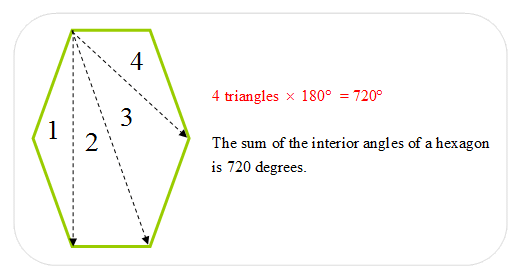 |
|
| |
| |
|
| |
|
|
Activity: Print out (right-click, print) or copy the table below. Fill in the results for the pentagon, hexagon, and octagon from above. Draw the other figures and complete the same activity. Draw nonoverlapping diagonals from one vertex to the other vertices to create all possible triangles, and then compute the sum of the interior angles by multiplying by 180 degrees. |
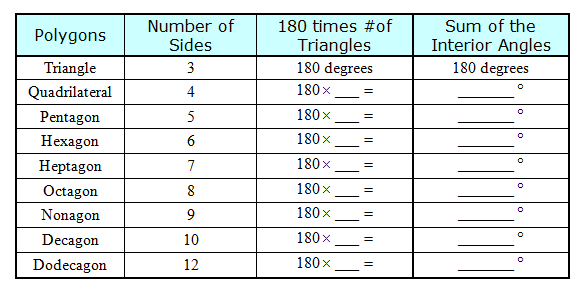 |
|
| |
| 6)
What is the sum of the interior angles of a (a) heptagon, (b) nonagon, (c) decagon, and (d) dodecagon? |
|
4000 character(s) left
Your answer is too long. |
|
| |
|
| 7)
Look for a pattern in the table between the number of sides in the polygon and the number of triangles determined by connecting one vertex to all the other vertices. If “n” represents the number of sides of a polygon, which formula could be used to determine the total numbers of degrees of the interior angles in any polygon? |
|
|
|
| |
|
| |
|
| 9)
What is the difference between a polygon and a regular polygon? |
|
4000 character(s) left
Your answer is too long. |
|
|
Attachments |
|
| |
|
| |
|
| |
|
| 13)
What is (a) the measure of an interior angle of the REGULAR hexagon and (b) the measure of an exterior angle of a regular hexagon? |
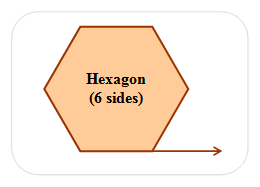 |
4000 character(s) left
Your answer is too long. |
|
| |
|
| |
|
| |
|
| |
| 16)
Which statement is INCORRECT? |
|
|
|
| |
|
| 17)
True or False. The figure below has the properties of a parallelogram, a rectangle, a rhombus, and a square. (Note: The blue hash marks denote congruent sides and the corner squares denote right angles.) |
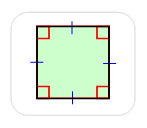 |
|
|
| |
|
| |
|
| |
|
| 20)
What are the measures of two consecutive angles in the given parallelogram where “x” represents the smaller angle and “3x” represents the larger angle? |
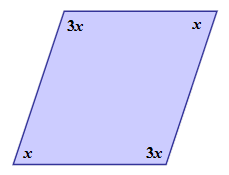 |
|
|
| |
|
| |
|
| |
| 22)
Is the given sequence an ARITHMETIC sequence? If so, what is the common difference and what are the next three terms. If not, just state “no”. |
 |
4000 character(s) left
Your answer is too long. |
|
| |
|
| |
|
| 24)
For the given GEOMETRIC sequence, (a) what is the common ratio of the sequence, and (b) what are the next three terms of the sequence? |
 |
4000 character(s) left
Your answer is too long. |
|
| |
|
| |
|
| |
|
| 27)
The given sequence is what type of sequence? |
 |
|
|
| |
|
| |
|
| |
|
| |
|
| |
|
| 32)
The sequence below is a set of numbers that are referred to as triangular numbers since they can be modeled as shown. The sequence is neither arithmetic nor geometric, but there is a pattern to determine each term of the sequence. Look for a pattern in the numbers and/or figures, and then state the next five terms in the sequence. |
 |
4000 character(s) left
Your answer is too long. |
|
| |
|
| 33)
There are many kinds of sequences other than arithmetic or geometric. The Fibonacci sequence is just one special sequence where addition is used to determine the next term; but, it is not an arithmetic sequence. (a) What are the next three terms in the given sequence? (b) Explain how to calculate any term in the Fibonacci sequence. |
 |
4000 character(s) left
Your answer is too long. |
|
| |
|
|
The spiral seed patterns in sunflowers are connected to the Fibonacci Sequence. Two numbers in the Fibonacci sequence will occur as the number of seeds in the two crisscrossing spiral seed patterns in any sunflower. Can you find the two numbers of the Fibonacci Sequence show in the picture below? |
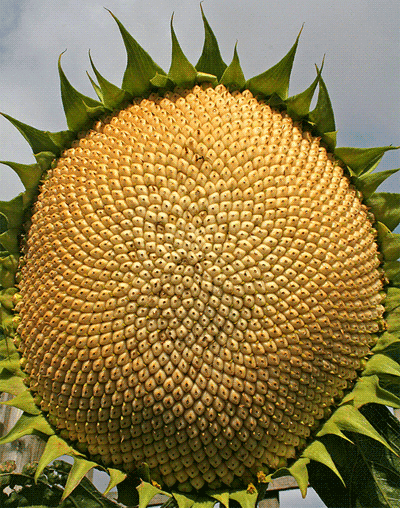 |
|
| |
| 34) If you were directed by your school to complete Offline Activities for this course, please enter the information on the Log Entry form. |
|
| No offline activities found |
0 Hour(s) & 0 Minute(s)
|
|
|
Attachments |
|